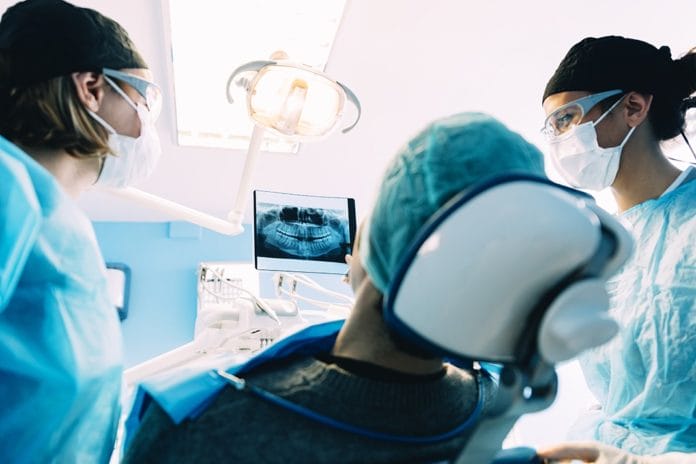The dental hygiene diagnosis is an integral part of a dental hygiene appointment. It allows for the collection of data to be formulated into an oral health care plan that is patient-specific in order to obtain optimum oral health care instruction. Consequently, the dental hygiene diagnosis has gained a heightened awareness by the American Dental Association (ADA), the American Dental Hygiene Association (ADHA), the Commission of Dental Accreditation (CODA), and clinical teaching institutions, as the role of the dental hygienist has broadened.
Throughout my career, as a practicing dental hygienist, I have heard countless times the statement from fellow dental hygienists, “I was taught not to diagnose.” This statement perplexes me, considering our duties predicate a diagnosis. In most clinical settings, the dental hygienist spends three-quarters more time chair-side than the doctor during a routine examination. Therefore, it only makes sense to bring the doctor up to speed on the patient’s needs prior to his or her examination.
A diagnostic of the patient by the dental hygienist includes clinical findings, radiographic findings, oral home care needs, and future oral care needs. By definition, a diagnosis is “The identification of the nature of an illness or other problems by examination of the symptoms.”1 The confusion regarding the legalities of the dental hygiene diagnosis pertains to the limitations placed on the dental hygienist in a clinical setting. Addressing the definition of the dental hygiene diagnosis and the roles of the dental hygienist may bring clarity to this confusing topic.
The American Dental Hygienists’ Association (ADHA) developed Applied Standards of Clinical Dental Hygiene Practice in 1985. In 2010, The Commission on Dental Accreditation (CODA) removed the dental hygiene diagnosis from accreditation standards for dental hygiene, which was prompted by the American Dental Association House of Delegates in 2007.2 The ADHA’s guide on Clinical Practice of the Dental Hygienist was last revised in 2016 to include the dental hygiene diagnosis. Recently, the ADHA has advocated for a revision to the clinical practice of dental hygiene in reference to the “dental hygiene diagnosis.”3 However, as of the writing of this article only two states, Colorado and Oregon, officially recognize the dental hygiene diagnosis as part of a hygienist’s scope of practice.
The ADHA has taken the position which supports the dental hygiene diagnosis, and has defined it as, “The identification of an individual’s health behaviors, attitudes, and oral health care needs for which a dental hygienist is educationally qualified and licensed to provide.”4 The dental hygiene diagnosis, including the planning and evaluating phases, must be implemented within the scope of the licensure requirements. The Applied Standards of the Clinical Dental Hygiene Practice defines dental hygiene as, “The science and practice of recognition, prevention, and treatment of oral disease and conditions as an integral component of total health.”5
The Applied Standards for Clinical Dental Hygiene Practice breaks down the dental hygienist duties in phases: Assessment, Dental Hygiene Diagnosis, Planning, Implementation, Evaluation, and Documentation. These phases were adopted to guarantee the quality of care.5
During a dental hygiene appointment, the assessment phase includes collecting, documenting, and analyzing data. First, the dental hygienist documents the patient’s health status and needs. This allows the dental hygienist to determine if any health conditions or medications may be a precursor to oral manifestations. Then the clinical evaluation assesses dental and periodontal charting, tooth caries, tooth fractures, demineralization, plaque, calculus and stain build-up, saliva consistency, oral lesions, pocket depths, recession, soft tissue inflammation, and bleeding. A radiographic examination assesses incipient and carious lesions, periapical abscessing, bone loss and any other radiographic artifacts.
Next, based on the clinical and radiographic evaluations, the dental hygienist performs a dental hygiene diagnosis using the findings to identify any potential oral health problems. The dental hygienist then implements a plan of care based on the previous findings to help reach maximum oral health. Following the planning phase, the dental hygienist performs dental hygiene services based on patient needs. Finally, the dental hygienist reviews the outcome of the dental hygiene services prior to the doctor’s examination, after which, the dental hygienist records the data and treatment recommendations. Based on the time table of a dental hygiene appointment, the dental hygienist’s failure to diagnose would be a disadvantage to the patient and for the examining doctor.
The dental hygiene diagnosis is an important and vital part of the dental hygiene appointment. It not only allows the dental hygienist to meet the standard of care but is also beneficial to the examining doctor. A crucial argument for the dental hygienist diagnosis and the need for the dental hygienist to communicate this with the doctor is to understand the examining doctor may be unaware of any of the needs that were assessed prior to dental hygienist treatment.
Therefore, for a dental hygienist to shy away from diagnosing would be a failure to meet the standard of care and licensure requirements. Thus, the dental hygiene diagnosis is a crucial phase of any dental hygiene appointment and allows for a successful outcome of optimal oral health with patient compliance.
References
- Definition of Diagnosis. Wikipedia. Sourced from https://en.wikipedia.org/wiki/Diagnosis
- ADA Remains Committed to Advancing Dental Hygiene Education Standards Despite CODA Opposition. American Dental Hygiene Association; August 15, 2018. Retrieved from http://www.adha.org/resources-docs/ADHA_CODA_Statement_8-15-18.pdf
- Advocacy: Changes to Accreditation Standards for Dental Hygiene Education Programs. American Dental Hygiene Association. Retrieved from https://www.ADHA.org/changes-to-accreditation-standards-for-dental-hygiene-education-programs
- Dental Hygiene Diagnosis. September 2015. American Dental Hygiene Association. Retrieved from http://www.adha.org/resources-docs/Diagnosis-Position-Paper.pdf
- Standards for Clinical Dental Hygiene Practice. (2016) American Dental Hygiene Association. Retrieved from https://www.adha.org/resources-docs/2016-Revised-Standards-for-Clinical-Dental-Hygiene-Practice.pdf











